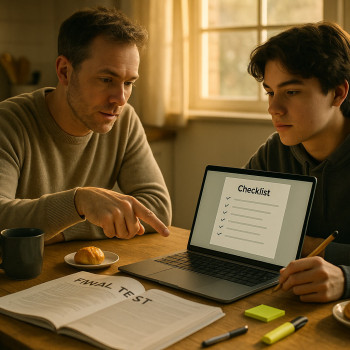The secret ingredient top scorers don’t talk about enough: critical thinking
When students prepare for the Digital SAT, they often focus on content—vocabulary lists, math formulas, timing drills. That’s important, of course. But there’s another skill that quietly underpins almost every question on the test: critical thinking. This isn’t a mysterious superpower. It’s a set of habits and techniques you can learn and practice, and when you do, your comprehension, accuracy, and speed all climb together.
Why critical thinking matters more on the Digital SAT
The Digital SAT changed the delivery and format, but the core goals remain: measure how well you can read closely, reason with evidence, and solve problems. Because the test is adaptive and often presents questions that reward interpretation over memorization, strong critical thinking helps you:
- Decode what a question is actually asking (not what you think it’s asking).
- Weed out tempting answer choices that look right at first glance.
- Connect data or a short passage to a clear, logical conclusion.
- Choose efficient solving strategies that save time without sacrificing accuracy.
Think of critical thinking as the engine that turns raw knowledge into test performance.
What does critical thinking look like on each SAT section?
Reading and Writing
Here the test rewards evidence-based reasoning. You’re not being asked to impress with fancy vocabulary; you’re being asked to read a passage, understand the author’s point, and select answers that follow logically from the text. Critical thinking strategies that matter:
- Predict before you peek: After reading the question stem, try to predict the answer in your head before scanning choices. If none match your prediction, return to the passage and search for the precise phrase or sentence that supports your idea.
- Beware extremes: Answers that use absolute language (“always,” “never,” “completely”) are often traps unless the passage says those words or clearly implies them.
- Evidence first: Favor answers that can be located or inferred from specific lines in the passage—not those that rely on outside knowledge or general impressions.
Math
Beyond knowing algebra and geometry, the Digital SAT’s math problems reward logical structure and clean reasoning. That’s where critical thinking makes the difference:
- Work backward when appropriate: If the question asks for an unknown and you have answer choices, plug the choices in quickly to see which one fits the conditions.
- Estimate to eliminate: Before computing precisely, approximate to rule out wildly off choices—this saves time and reduces careless errors.
- Read the units: Sometimes a small misread (percentage vs. decimal; yards vs. meters) wrecks an otherwise correct solution. Clarify what the question requires before manipulating expressions.
Table of common question types and the critical thinking move that helps most
| Question Type | Core Critical Thinking Move | Quick Example |
|---|---|---|
| Inference from passage | Find the evidence sentence; ask “what does this sentence imply?” | Author mentions rainfall trends → infer impact on crops, not weather trivia. |
| Function/graph interpretation | Translate visuals into words: what is increasing/decreasing? | Slope positive → value rising; where is slope zero? |
| Multi-step algebra | Map the problem into smaller subproblems; label variables clearly. | Two equations, two unknowns → solve stepwise, check answers for extraneous roots. |
| Sentence correction | Read the sentence aloud; track subject-verb agreement and parallelism. | “Running, walked, and sleeps” → identify inconsistent verb forms. |
Concrete critical thinking techniques you can practice
1. The Question-Sentence-Passage triage
When you open a Reading or Writing question, use this quick three-step triage:
- Question: Read the question stem and underline the exact task word (infer, best support, main idea).
- Sentence: If it cites a line, read that sentence and the one before and after it. Context often matters.
- Passage: Skim the passage looking for corroborating or contradictory language. Choose the answer that has direct support.
2. Reverse-engineering wrong answers
Wrong choices on the SAT aren’t random—they’re designed to lure you. When you practice, don’t just note which choice is correct; note why the other choices are wrong. Classifying distractors helps you spot the same traps on test day:
- Out-of-scope: Uses information not present in the passage.
- Half-right: Contains a true fact but doesn’t answer what the question asked.
- Extreme: Overstates the passage’s claim.
3. The 4C math checklist: Clarify, Convert, Consider, Check
A short checklist for math problems that helps avoid silly mistakes:
- Clarify: Restate what’s being asked in one sentence.
- Convert: Put all units and expressions into a consistent setup.
- Consider: Think about special cases (zero, negative, large numbers) to test your approach.
- Check: Quickly plug your answer back into the original conditions to confirm.
Practice routines that build critical thinking — and how to measure progress
A weekly plan you can follow
Turn critical thinking into a habit with a steady, focused schedule. Here’s an effective weekly practice rhythm you can adapt:
- Day 1 — Diagnostic set: 20 mixed Reading and Math questions. Time yourself. Mark questions you guessed or felt uncertain about.
- Day 2 — Error analysis: For each missed or guessed question, write a one-sentence explanation of the error and what the trap was (e.g., misread unit, inference beyond text).
- Day 3 — Targeted skill work: 30 minutes on one weak area (logical inference, algebraic manipulation, data interpretation).
- Day 4 — Timed mini-section: 25 questions in a reduced block to practice pacing with critical thinking strategies.
- Day 5 — Mixed review: Reattempt problems you missed from earlier in the week and note improvement.
- Weekend — Full practice: One realistic adaptive practice test on the Bluebook app or an official practice set; do full review afterward.
How to track improvement
Don’t just count correct answers. Track the quality of your reasoning. Use a simple spreadsheet with these columns:
- Question ID
- Correct/Incorrect
- Reason for error (if any)
- Time spent
- Confidence level (1–5)
After four weeks, you’ll see patterns: maybe your confidence is high but you’re missing inference questions, or you’re spending too long on multi-step algebra. That insight is the point—knowledge without reflection isn’t progress.
Examples that show critical thinking in action
Reading passage example
Imagine a short passage about urban gardens and a question: “Which sentence best supports the author’s claim that community gardens improve neighborhood resilience?” A surface reader might pick a sentence that mentions “increased social interaction.” A critical thinker will look for a sentence tying gardens to measurable outcomes—reduced food insecurity, shared resources during emergencies, or documented participation statistics. The difference is the link to the claim: social interaction hints at resilience; documented outcomes support it.
Math example
Problem: A rectangle’s length is 30% longer than its width. The area is 52. Find the width. A quick critical-thinking approach:
- Clarify: Let width = w, length = 1.3w. Area = w * 1.3w = 1.3w^2 = 52.
- Convert: w^2 = 52 / 1.3 = 40. So w = sqrt(40) ≈ 6.3249.
- Consider: Check if approximate width fits context and whether answer choices (if multiple-choice) match a simplified radical (2√10 ≈ 6.3249).
Instead of fumbling with decimals, you could also manipulate the expression exactly and recognize the radical form—saving time and avoiding rounding errors.
Common pitfalls and how to fix them
Pitfall 1: Relying on intuition without evidence
Intuition helps in everyday life but the SAT rewards evidence. Fix it by always asking, “Where in the passage or problem is the proof?” If you can’t point to it, you’ve guessed.
Pitfall 2: Skipping error analysis
Many students retake practice tests but don’t dissect mistakes. When you skip analysis, you re-learn the same wrong approach. Spend at least as much time reviewing as you do testing; often more.
Pitfall 3: Unstructured practice
Doing random questions is okay for warm-up, but deep improvement comes from targeted practice—work on one skill until you see measurable gains.
How tutoring and personalized study plans accelerate critical thinking
Learning critical thinking is a personal journey. Two students may make the same mistake for very different reasons—one misreads questions when anxious, another lacks a strategy for data interpretation. Personalized tutoring helps diagnose the root cause and repair it efficiently. Sparkl’s personalized tutoring offers 1‑on‑1 guidance, tailored study plans, expert tutors, and AI-driven insights that highlight specific weak spots. When a tutor models the thought process aloud—why they ruled a choice out, how they mapped variables—students internalize that approach and apply it independently.
What to expect from focused 1-on-1 coaching
- Individual diagnostics that separate knowledge gaps from reasoning habits.
- Guided practice with immediate feedback; your tutor points out not just the mistake, but the thinking pattern behind it.
- Customized drills focused on your highest-leverage weaknesses.
- Periodic recalibration: as you improve, the plan shifts so you’re always working at the edge of your ability.
Building test-day resilience with critical thinking
Calm, systematic routines beat panic
Test anxiety makes even simple reasoning feel hard. Use these habits on test day:
- Warm up with two short practice questions to get into the reasoning rhythm.
- Read each question twice: first for the task, second for details that matter.
- Mark and move: If you’re stuck for more than 90 seconds, mark the question and return. Often the answer becomes clearer after nearby questions change your mindset.
Time management with critical thinking
Critical thinking doesn’t mean you must solve every problem fully on the first pass. It means you allocate your brainpower where it’s most productive. Triage questions by expected time and point value. Use quick reasoning (predict-and-eliminate) for faster questions and deeper reasoning for higher-payoff items.
Using digital tools wisely: practice that mirrors the test
The Digital SAT environment is different from paper—screen layout, navigation, and adaptive sections all influence strategy. Practice on the official Bluebook app or adaptive practice sets when you can so your critical thinking transfers to the real interface. When practicing, simulate test-day conditions: same screen size, same timing, and full sections. Treat the digital tools (notebooks, line references) as part of the reasoning process rather than distractions.
Putting it all together: a 6-week intensive plan
If you have six weeks until a practice or real test, here’s a compact plan that prioritizes critical thinking over rote memorization.
- Weeks 1–2: Diagnostic + foundations. Do a full practice test. Identify the three most common error types (e.g., inference mistakes, algebra slips, timing issues). Spend daily practice addressing one error type with targeted drills.
- Weeks 3–4: Strategy and application. Work under timed conditions with a focus on the triage methods described above. Start tracking confidence and time per question.
- Week 5: Simulation and refinement. Take two full, timed digital practice tests on the Bluebook platform. After each, do a thorough error analysis and adjust your plan.
- Week 6: Polishing and calm. Reduce study time slightly, keep review targeted, practice relaxation and pacing techniques, and finish with one realistic test 3–4 days before exam day.
How to measure success beyond the score
Scores matter, but so does the quality of thinking. Celebrate these wins:
- Fewer careless mistakes on problems that used to trip you up.
- Faster ability to predict correct answers or eliminate distractors.
- Higher confidence and lower test anxiety—the hallmark of reliable reasoning.
Closing thoughts: critical thinking is a muscle — you can strengthen it
The Digital SAT rewards students who can think clearly under pressure. The good news is that critical thinking isn’t fixed; it’s a set of skills you can practice, measure, and refine. When you combine regular, reflective practice with targeted feedback—whether from a coach, a structured program, or Sparkl’s personalized tutoring with 1‑on‑1 guidance, tailored study plans, expert tutors, and AI-driven insights—you accelerate that improvement.
Start small: one hour a day of focused practice with explicit error analysis will produce visible gains in a few weeks. Be deliberate about why you missed each question, and keep a notebook of reasoning patterns you’ve learned. Over time, those habits become automatic, and the SAT becomes less about nerves and more about applying the clear, logical thinking you already possess.
Parting tip
On test day, trust your process. If you’ve practiced thinking clearly, reviewing errors, and applying a few reliable strategies, your brain will recognize the right moves—even when the clock is counting down. That calm, evidence-based thinking is the real edge.
Good luck—and remember: the Digital SAT is as much a test of how you think as what you know. Strengthen your reasoning, practice deliberately, and the score will follow.














No Comments
Leave a comment Cancel